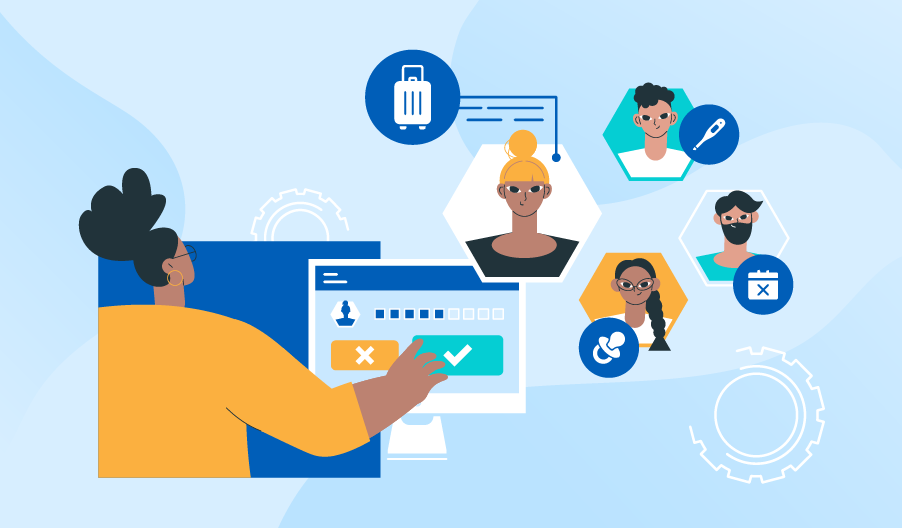Best Practices for Implementing Leave Management Software in Your Organization
Efficient leave management is an important aspect of every organization’s human resource operations. Managing employee leave requests, approvals, and records manually can be time-consuming and error-prone, resulting in unhappiness and lower productivity. Implementing the best leave management software provides a streamlined, automated option that can considerably boost accuracy and productivity. This detailed handbook describes the best practices for using leave management software in your firm, enabling a smooth transition and maximizing its benefits.

Understanding Your Needs
Before entering into the selection and deployment of leave management software, it’s critical to evaluate your organization’s unique needs. Begin by identifying the issues and pain points in your current leave management process. Are there regular inaccuracies in leave balances? Is the approvals process slow and inefficient? Do employees have trouble accessing their leave records?
Set explicit goals for the new system once you’ve determined your present challenges. For example, you could seek to cut the time spent on leave approvals by half, remove human errors in leave calculations, or provide employees real-time access to their leave balance. Defining these goals can help you choose the proper software and measure its success after adoption.
Choosing the Right Software
The market offers a wide range of leave management software options, each with its unique features and capabilities. To choose the best software that fits for your organization, consider the following factors:
- User-Friendliness: The software should have an intuitive interface that is easy for both HR personnel and employees to navigate.
- Features and Functionality: Ensure the software offers essential features such as leave request and approval workflows, leave balance tracking, integration with payroll, and reporting capabilities.
- Scalability: The software should be able to grow with your organization, accommodating an increasing number of users and expanding functionality as needed.
- Integration: Check if the software can seamlessly integrate with your existing HR and payroll systems.
- Cost: Evaluate the total cost of ownership, including licensing fees, implementation costs, and ongoing maintenance.
Research different options by reading reviews, seeking recommendations from other organizations, and comparing features. Most vendors offer demo versions or free trials—take advantage of these to assess the software’s compatibility with your needs.
Planning the Implementation
A well-thought-out implementation strategy is required for the successful adoption of leave management software. Begin by creating a thorough timeline that includes defined milestones and deadlines. Set roles and responsibilities for team members to guarantee responsibility throughout the process.
Data migration is a vital part of the implementation process. Ensure that all existing leave data is moved correctly to the new system. This may include cleaning and arranging data to remove errors and inconsistencies. Conduct extensive testing to ensure that the data migration is successful and that the software is working as intended.
Include stakeholders from all departments to provide input and feedback during the planning phase. Their knowledge can assist spot potential problems and guarantee that the software satisfies the demands of all users.
Training and Support
Effective training is required to guarantee that staff use the new leave management software effectively. Create a comprehensive training session that covers all features of the software, including submitting leave requests and generating reports. Consider the training strategies listed below:
- Workshops and Training Sessions: Conduct hands-on workshops where employees can learn how to use the software in a guided environment.
- Training Materials: Provide user manuals, video tutorials, and FAQs that employees can refer to as needed.
- Ongoing Support: Establish a helpdesk or support system where employees can get assistance with any issues or questions that arise.
Offering continuous support is crucial, especially in the initial stages after the software goes live. Encourage feedback from users to identify areas where additional training may be needed and to address any challenges they encounter.
Integration with Existing Systems
To be effective, the leave management software must work seamlessly with your existing HR and payment systems. This guarantees that data flows seamlessly between systems, lowering the likelihood of errors and duplications. Work together with your IT department and software vendor to ensure compatibility and resolve any integration issues.
Conduct extensive integration testing to ensure that the systems work effectively together. This may entail running parallel processes to check that data is delivered correctly and that all capabilities are active. Collect user feedback to identify any issues that should be corrected prior to full launch.
Monitoring and Evaluation
Once the leave management software has been established, it is critical to monitor its performance and determine whether it satisfies your predefined goals. Establish key performance indicators (KPIs) to assess the software’s effectiveness. These indicators may include the time required to process leave requests, the frequency of inaccuracies in leave records, and user satisfaction levels.
Use analytics tools to track usage and find areas for improvement. Regularly evaluate the software’s performance and make any necessary changes to improve its functioning. Stay updated about new features and upgrades from the software vendor, and consider implementing them to improve the system’s functionality.
Case Studies and Success Stories
Learning from the experiences of other organizations can yield significant insights and best practices. Find case studies and success stories from firms that have effectively adopted leave management software. Examine how they handled the implementation process, the obstacles they encountered, and the solutions they implemented.
Sharing these success stories with your team can boost their trust in the new system and highlight its potential benefits. Consider contacting these groups for firsthand advice and recommendations.,
Conclusion
Implementing leave management software can improve your organization’s leave management processes by making them more efficient, accurate, and user-friendly. A successful implementation can be achieved by understanding your requirements, selecting the appropriate software, methodically planning the implementation, offering extensive training and support, ensuring smooth interface with existing systems, and regularly monitoring and evaluating performance.
Embracing this adjustment will boost overall productivity, eliminate errors, and increase employee happiness. Take the first step toward effective leave management.
Best Practices for Implementing Leave Management Software in Your Organization
Efficient leave management is an important aspect of every organization’s human resource operations. Managing employee leave requests, approvals, and records manually can be time-consuming and error-prone, resulting in unhappiness and lower productivity. Implementing the best leave management software provides a streamlined, automated option that can considerably boost accuracy and productivity. This detailed handbook describes the best practices for using leave management software in your firm, enabling a smooth transition and maximizing its benefits.
Understanding Your Needs
Before entering into the selection and deployment of leave management software, it’s critical to evaluate your organization’s unique needs. Begin by identifying the issues and pain points in your current leave management process. Are there regular inaccuracies in leave balances? Is the approvals process slow and inefficient? Do employees have trouble accessing their leave records?
Set explicit goals for the new system once you’ve determined your present challenges. For example, you could seek to cut the time spent on leave approvals by half, remove human errors in leave calculations, or provide employees real-time access to their leave balance. Defining these goals can help you choose the proper software and measure its success after adoption.
Choosing the Right Software
The market offers a wide range of leave management software options, each with its unique features and capabilities. To choose the best software that fits for your organization, consider the following factors:
- User-Friendliness: The software should have an intuitive interface that is easy for both HR personnel and employees to navigate.
- Features and Functionality: Ensure the software offers essential features such as leave request and approval workflows, leave balance tracking, integration with payroll, and reporting capabilities.
- Scalability: The software should be able to grow with your organization, accommodating an increasing number of users and expanding functionality as needed.
- Integration: Check if the software can seamlessly integrate with your existing HR and payroll systems.
- Cost: Evaluate the total cost of ownership, including licensing fees, implementation costs, and ongoing maintenance.
Research different options by reading reviews, seeking recommendations from other organizations, and comparing features. Most vendors offer demo versions or free trials—take advantage of these to assess the software’s compatibility with your needs.
Planning the Implementation
A well-thought-out implementation strategy is required for the successful adoption of leave management software. Begin by creating a thorough timeline that includes defined milestones and deadlines. Set roles and responsibilities for team members to guarantee responsibility throughout the process.
Data migration is a vital part of the implementation process. Ensure that all existing leave data is moved correctly to the new system. This may include cleaning and arranging data to remove errors and inconsistencies. Conduct extensive testing to ensure that the data migration is successful and that the software is working as intended.
Include stakeholders from all departments to provide input and feedback during the planning phase. Their knowledge can assist spot potential problems and guarantee that the software satisfies the demands of all users.
Training and Support
Effective training is required to guarantee that staff use the new leave management software effectively. Create a comprehensive training session that covers all features of the software, including submitting leave requests and generating reports. Consider the training strategies listed below:
- Workshops and Training Sessions: Conduct hands-on workshops where employees can learn how to use the software in a guided environment.
- Training Materials: Provide user manuals, video tutorials, and FAQs that employees can refer to as needed.
- Ongoing Support: Establish a helpdesk or support system where employees can get assistance with any issues or questions that arise.
Offering continuous support is crucial, especially in the initial stages after the software goes live. Encourage feedback from users to identify areas where additional training may be needed and to address any challenges they encounter.
Integration with Existing Systems
To be effective, the leave management software must work seamlessly with your existing HR and payment systems. This guarantees that data flows seamlessly between systems, lowering the likelihood of errors and duplications. Work together with your IT department and software vendor to ensure compatibility and resolve any integration issues.
Conduct extensive integration testing to ensure that the systems work effectively together. This may entail running parallel processes to check that data is delivered correctly and that all capabilities are active. Collect user feedback to identify any issues that should be corrected prior to full launch.
Monitoring and Evaluation
Once the leave management software has been established, it is critical to monitor its performance and determine whether it satisfies your predefined goals. Establish key performance indicators (KPIs) to assess the software’s effectiveness. These indicators may include the time required to process leave requests, the frequency of inaccuracies in leave records, and user satisfaction levels.
Use analytics tools to track usage and find areas for improvement. Regularly evaluate the software’s performance and make any necessary changes to improve its functioning. Stay updated about new features and upgrades from the software vendor, and consider implementing them to improve the system’s functionality.
Case Studies and Success Stories
Learning from the experiences of other organizations can yield significant insights and best practices. Find case studies and success stories from firms that have effectively adopted leave management software. Examine how they handled the implementation process, the obstacles they encountered, and the solutions they implemented.
Sharing these success stories with your team can boost their trust in the new system and highlight its potential benefits. Consider contacting these groups for firsthand advice and recommendations.
Conclusion
Implementing leave management software can improve your organization’s leave management processes by making them more efficient, accurate, and user-friendly. A successful implementation can be achieved by understanding your requirements, selecting the appropriate software, methodically planning the implementation, offering extensive training and support, ensuring smooth interface with existing systems, and regularly monitoring and evaluating performance.
Embracing this adjustment will boost overall productivity, eliminate errors, and increase employee happiness. Take the first step toward effective leave management.
